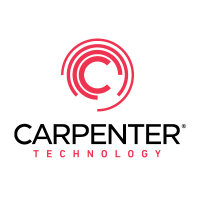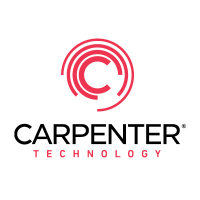
Carpenter Technology Corp
NYSE:CRS


| US |

|
Johnson & Johnson
NYSE:JNJ
|
Pharmaceuticals
|
| US |

|
Berkshire Hathaway Inc
NYSE:BRK.A
|
Financial Services
|
| US |

|
Bank of America Corp
NYSE:BAC
|
Banking
|
| US |

|
Mastercard Inc
NYSE:MA
|
Technology
|
| US |

|
UnitedHealth Group Inc
NYSE:UNH
|
Health Care
|
| US |

|
Exxon Mobil Corp
NYSE:XOM
|
Energy
|
| US |

|
Pfizer Inc
NYSE:PFE
|
Pharmaceuticals
|
| US |

|
Palantir Technologies Inc
NYSE:PLTR
|
Technology
|
| US |

|
Nike Inc
NYSE:NKE
|
Textiles, Apparel & Luxury Goods
|
| US |

|
Visa Inc
NYSE:V
|
Technology
|
| CN |

|
Alibaba Group Holding Ltd
NYSE:BABA
|
Retail
|
| US |

|
3M Co
NYSE:MMM
|
Industrial Conglomerates
|
| US |

|
JPMorgan Chase & Co
NYSE:JPM
|
Banking
|
| US |

|
Coca-Cola Co
NYSE:KO
|
Beverages
|
| US |

|
Walmart Inc
NYSE:WMT
|
Retail
|
| US |

|
Verizon Communications Inc
NYSE:VZ
|
Telecommunication
|
Utilize notes to systematically review your investment decisions. By reflecting on past outcomes, you can discern effective strategies and identify those that underperformed. This continuous feedback loop enables you to adapt and refine your approach, optimizing for future success.
Each note serves as a learning point, offering insights into your decision-making processes. Over time, you'll accumulate a personalized database of knowledge, enhancing your ability to make informed decisions quickly and effectively.
With a comprehensive record of your investment history at your fingertips, you can compare current opportunities against past experiences. This not only bolsters your confidence but also ensures that each decision is grounded in a well-documented rationale.
Do you really want to delete this note?
This action cannot be undone.

| 52 Week Range |
59.06
196.14
|
| Price Target |
|
We'll email you a reminder when the closing price reaches USD.
Choose the stock you wish to monitor with a price alert.

|
Johnson & Johnson
NYSE:JNJ
|
US |

|
Berkshire Hathaway Inc
NYSE:BRK.A
|
US |

|
Bank of America Corp
NYSE:BAC
|
US |

|
Mastercard Inc
NYSE:MA
|
US |

|
UnitedHealth Group Inc
NYSE:UNH
|
US |

|
Exxon Mobil Corp
NYSE:XOM
|
US |

|
Pfizer Inc
NYSE:PFE
|
US |

|
Palantir Technologies Inc
NYSE:PLTR
|
US |

|
Nike Inc
NYSE:NKE
|
US |

|
Visa Inc
NYSE:V
|
US |

|
Alibaba Group Holding Ltd
NYSE:BABA
|
CN |

|
3M Co
NYSE:MMM
|
US |

|
JPMorgan Chase & Co
NYSE:JPM
|
US |

|
Coca-Cola Co
NYSE:KO
|
US |

|
Walmart Inc
NYSE:WMT
|
US |

|
Verizon Communications Inc
NYSE:VZ
|
US |
This alert will be permanently deleted.
 Carpenter Technology Corp
Carpenter Technology Corp
Carpenter Technology Corp
Investor Relations
Carpenter Technology Corp., a decades-old stalwart rooted in advanced manufacturing, built its reputation on crafting specialty alloys that meet the sophisticated demands of industries such as aerospace, defense, medical, and energy. Headquartered in Pennsylvania, this company elegantly molds and engineers materials to exacting specifications, understanding that the very integrity of a spacecraft, the invulnerability of a jet engine, and the precision of medical implants often hinge on the quality of the alloys used. By fusing science with craftsmanship, Carpenter orchestrates a symphony of metallurgical innovation, meticulously controlling elements down to the atomic level to forge metals capable of withstanding extreme conditions. It's this precision and high-quality output that forms the core of Carpenter's business—following the chain from ore to alloy composition, right through rolling, extrusion, and finishing to final product.
Revenue streams for Carpenter Technology are primarily anchored in the process of alloy customization and production for a global client base that requires exacting specifications. When aerospace manufacturers need components that boast strength without sacrificing weight, or when the oil and gas industry seeks materials capable of enduring punishing environments, they turn to Carpenter for solutions that can often only be sourced from a handful of providers worldwide. Additionally, Carpenter doesn’t just rest on the materials themselves; it offers value-added services such as consulting on design and application, translating specialized knowledge into skilled advice for cost efficiencies and performance improvements. This blend of expertly crafted materials and strategic service offerings fortifies Carpenter Technology’s standing as a leader in its field, underscoring its financial returns and expansion into ever-evolving markets.

Carpenter Technology Corp., a decades-old stalwart rooted in advanced manufacturing, built its reputation on crafting specialty alloys that meet the sophisticated demands of industries such as aerospace, defense, medical, and energy. Headquartered in Pennsylvania, this company elegantly molds and engineers materials to exacting specifications, understanding that the very integrity of a spacecraft, the invulnerability of a jet engine, and the precision of medical implants often hinge on the quality of the alloys used. By fusing science with craftsmanship, Carpenter orchestrates a symphony of metallurgical innovation, meticulously controlling elements down to the atomic level to forge metals capable of withstanding extreme conditions. It's this precision and high-quality output that forms the core of Carpenter's business—following the chain from ore to alloy composition, right through rolling, extrusion, and finishing to final product.
Revenue streams for Carpenter Technology are primarily anchored in the process of alloy customization and production for a global client base that requires exacting specifications. When aerospace manufacturers need components that boast strength without sacrificing weight, or when the oil and gas industry seeks materials capable of enduring punishing environments, they turn to Carpenter for solutions that can often only be sourced from a handful of providers worldwide. Additionally, Carpenter doesn’t just rest on the materials themselves; it offers value-added services such as consulting on design and application, translating specialized knowledge into skilled advice for cost efficiencies and performance improvements. This blend of expertly crafted materials and strategic service offerings fortifies Carpenter Technology’s standing as a leader in its field, underscoring its financial returns and expansion into ever-evolving markets.





























 You don't have any saved screeners yet
You don't have any saved screeners yet
